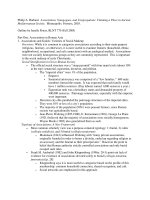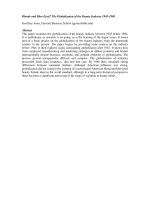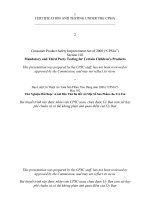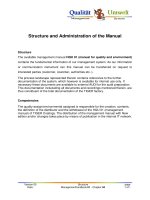Tài liệu Marijuana and Medicine: Assessing the Science Base ppt
Bạn đang xem bản rút gọn của tài liệu. Xem và tải ngay bản đầy đủ của tài liệu tại đây (11.25 MB, 286 trang )
PREFACE i
Janet E. Joy, Stanley J. Watson, Jr., and
John A. Benson, Jr.,
Editors
Division of Neuroscience and Behavioral Health
INSTITUTE OF MEDICINE
NATIONAL ACADEMY PRESS
Washington, D.C.
Assessing the Science Base
Marijuana
and Medi
c
ine
NATIONAL ACADEMY PRESS • 2101 Constitution Avenue, N.W. • Washington, D.C. 20418
NOTICE: The project that is the subject of this report was approved by the Governing Board
of the National Research Council, whose members are drawn from the councils of the Na-
tional Academy of Sciences, the National Academy of Engineering, and the Institute of Medi-
cine. The principal investigators responsible for the report were chosen for their special
competences and with regard for appropriate balance.
The Institute of Medicine was chartered in 1970 by the National Academy of Sciences
to enlist distinguished members of the appropriate professions in the examination of policy
matters pertaining to the health of the public. In this, the Institute acts under both the
Academy’s 1863 congressional charter responsibility to be an adviser to the federal govern-
ment and its own initiative in identifying issues of medical care, research, and education. Dr.
Kenneth I. Shine is president of the Institute of Medicine.
This study was supported under Contract No. DC7C02 from the Executive Office of the
President, Office of National Drug Control Policy.
Library of Congress Cataloging-in-Publication Data
Marijuana and medicine : assessing the science base / Janet E. Joy,
Stanley J. Watson, Jr., and John A. Benson, Jr., editors ; Division
of Neuroscience and Behavioral Health, Institute of Medicine.
p. cm.
Includes bibliographical references and index.
ISBN 0-309-07155-0 (hardcover)
1. Marijuana—Therapeutic use. 2. Cannabinoids—Therapeutic use.
I. Joy, Janet E. (Janet Elizabeth), 1953- II. Watson, Stanley J.,
1943- III. Benson, John A. IV. Institute of Medicine (U.S.).
Division of Neuroscience and Behavioral Health.
RM666.C266 M365 1999
615′.32345—dc21
99-6484
Additional copies of this report are available for sale from the National Academy Press,
2101 Constitution Avenue, N.W., Lock Box 285, Washington, D.C. 20055. Call (800) 624-6242
or (202) 334-3313 (in the Washington metropolitan area), or visit the NAP’s online bookstore
at www.nap.edu.
The full text of this report is available online at www.nap.edu.
For more information about the Institute of Medicine, visit the IOM home page at:
www4.nas.edu/IOM/.
Copyright 1999 by the National Academy of Sciences. All rights reserved.
Printed in the United States of America
Cover: Illustration from Marijuana Botany by Robert Connell Clarke, Ronin Publishing, 1981.
The serpent has been a symbol of long life, healing, and knowledge among almost all
cultures and religions since the beginning of recorded history. The image adopted as a logo-
type by the Institute of Medicine is based on a relief carving from ancient Greece, now held
by the Staatliche Museen in Berlin.
PRINCIPAL INVESTIGATORS AND ADVISORY PANEL
JOHN A. BENSON, JR. (Co-Principal Investigator), Dean and Professor
of Medicine, Emeritus, Oregon Health Sciences University School of
Medicine
STANLEY J. WATSON, JR. (Co-Principal Investigator), Co-Director and
Research Scientist, Mental Health Research Institute, University of
Michigan
STEVEN R. CHILDERS, Professor of Physiology and Pharmacology,
Center for Neuroscience, Bowman Gray School of Medicine, Wake
Forest University
J. RICHARD CROUT, President of Crout Consulting, Drug
Development and Regulation, Bethesda, Maryland
THOMAS J. CROWLEY, Professor, Department of Psychiatry, and
Executive Director, Addiction Research and Treatment Services,
University of Colorado Health Sciences Center
JUDITH FEINBERG, Professor, Department of Internal Medicine, and
Associate Director, Division of Infectious Diseases, University of
Cincinnati School of Medicine
HOWARD L. FIELDS, Professor of Neurology and Physiology,
University of California at San Francisco
DOROTHY HATSUKAMI, Professor of Psychiatry, University of
Minnesota
ERIC B. LARSON, Medical Director, University of Washington Medical
Center, and Associate Dean for Clinical Affairs, University of
Washington
BILLY R. MARTIN, Professor of Pharmacology and Toxicology, and
Director of National Institute on Drug Abuse Center on Drug
Abuse, Medical College of Virginia, Virginia Commonwealth
University
TIMOTHY L. VOLLMER, Professor of Medicine, Multiple Sclerosis
Research Center, Yale University School of Medicine
Study Staff
JANET E. JOY, Study Director
DEBORAH O. YARNELL, Research Associate
AMELIA B. MATHIS, Project Assistant
CHERYL MITCHELL, Administrative Assistant (until September 1998)
THOMAS J. WETTERHAN, Research Assistant (until September 1998)
CONSTANCE M. PECHURA, Division Director (until April 1998)
NORMAN GROSSBLATT, Manuscript Editor
iii
Consultant
MIRIAM DAVIS
Section Staff
CHARLES H. EVANS, JR., Head, Health Sciences Section
LINDA DEPUGH, Administrative Assistant
CARLOS GABRIEL, Financial Associate
iv
Reviewers
This report has been reviewed in draft form by individuals chosen for
their diverse perspectives and technical expertise, in accordance with pro-
cedures approved by the National Research Council’s Report Review
Committee. The purpose of this independent review is to provide candid
and critical comments that will assist the Institute of Medicine in making
the published report as sound as possible and to ensure that the report
meets institutional standards for objectivity, evidence, and responsive-
ness to the study charge. The review comments and draft manuscript re-
main confidential to protect the integrity of the deliberative process. The
committee wishes to thank the following individuals for their participa-
tion in the review of this report:
JAMES C. ANTHONY, Johns Hopkins University
JACK D. BARCHAS, Cornell University Medical College
SUMNER H. BURSTEIN, University of Massachusetts Medical School
AVRAM GOLDSTEIN, Stanford University
LESTER GRINSPOON, Harvard Medical School
MILES HERKENHAM, National Institute of Mental Health, National
Institutes of Health, Bethesda, Maryland
HERBERT D. KLEBER, Columbia University
GEOFFREY M. LEVITT, Venable Attorneys at Law, Washington, D.C.
KENNETH P. MACKIE, University of Washington
RAPHAEL MECHOULAM, The Hebrew University of Jerusalem
CHARLES P. O’BRIEN, University of Pennsylvania
JUDITH G. RABKIN, Columbia University
v
vi REVIEWERS
ERIC G. VOTH, International Drug Strategy Institute, Topeka, Kansas
VIRGINIA V. WELDON, Washington University
While the individuals listed above provided constructive comments
and suggestions, it must be emphasized that responsibility for the final
content of this report rests entirely with the authoring committee and the
Institute of Medicine.
Preface
Public opinion on the medical value of marijuana has been
sharply divided. Some dismiss medical marijuana as a
hoax that exploits our natural compassion for the sick; oth-
ers claim it is a uniquely soothing medicine that has been
withheld from patients through regulations based on false
claims. Proponents of both views cite “scientific evidence”
to support their views and have expressed those views at
the ballot box in recent state elections. In January 1997, the
White House Office of National Drug Control Policy
(ONDCP) asked the Institute of Medicine to conduct a review of the scien-
tific evidence to assess the potential health benefits and risks of marijuana
and its constituent cannabinoids. That review began in August 1997 and
culminates with this report.
The ONDCP request came in the wake of state “medical marijuana”
initiatives. In November 1996, voters in California and Arizona passed
referenda designed to permit the use of marijuana as medicine. Although
Arizona’s referendum was invalidated five months later, the referenda
galvanized a national response. In November 1998, voters in six states
(Alaska, Arizona, Colorado, Nevada, Oregon, and Washington) passed
ballot initiatives in support of medical marijuana. (The Colorado vote will
not count, however, because after the vote was taken a court ruling deter-
mined there had not been enough valid signatures to place the initiative
on the ballot.)
vii
viii PREFACE
Information for this study was gathered through scientific workshops,
site visits to cannabis buyers’ clubs and HIV/AIDS clinics, analysis of the
relevant scientific literature, and extensive consultation with biomedical
and social scientists. The three 2-day workshops—in Irvine, California;
New Orleans, Louisiana; and Washington, D.C.—were open to the public
and included scientific presentations and individual reports, mostly from
patients and their families, about experiences with and perspectives on
the medical use of marijuana. Scientific experts in various fields were se-
lected to talk about the latest research on marijuana, cannabinoids, and
related topics. (Cannabinoids are drugs with actions similar to THC, the
primary psychoactive ingredient in marijuana.) In addition, advocates for
and against the medical use of marijuana were invited to present scien-
tific evidence in support of their positions. Finally, the Institute of Medi-
cine appointed a panel of nine experts to advise the study team on techni-
cal issues.
Public outreach included setting up a Web site that provided infor-
mation about the study and asked for input from the public. The Web site
was open for comment from November 1997 until November 1998. Some
130 organizations were invited to participate in the public workshops.
Many people in the organizations—particularly those opposed to the
medical use of marijuana—felt that a public forum was not conducive to
expressing their views; they were invited to communicate their opinions
(and reasons for holding them) by mail or telephone. As a result, roughly
equal numbers of persons and organizations opposed to and in favor of
the medical use of marijuana were heard from.
Advances in cannabinoid science over the past 16 years have given
rise to a wealth of new opportunities for the development of medically
useful cannabinoid-based drugs. The accumulated data suggest a variety
of indications, particularly for pain relief, antiemesis, and appetite stimu-
lation. For patients who suffer simultaneously from severe pain, nausea,
and appetite loss, such as those with AIDS or who are undergoing che-
motherapy, cannabinoid drugs might offer broad-spectrum relief not
found in any other single medication.
Marijuana is not a completely benign substance. It is a powerful drug
with a variety of effects. However, the harmful effects to individuals from
the perspective of possible medical use of marijuana are not necessarily
the same as the harmful physical effects of drug abuse.
Although marijuana smoke delivers THC and other cannabinoids to
the body, it also delivers harmful substances, including most of those
found in tobacco smoke. In addition, plants contain a variable mixture of
biologically active compounds and cannot be expected to provide a pre-
PREFACE ix
cisely defined drug effect. For those reasons, the report concludes that the
future of cannabinoid drugs lies not in smoked marijuana but in chemi-
cally defined drugs that act on the cannabinoid systems that are a natural
component of human physiology. Until such drugs can be developed and
made available for medical use, the report recommends interim solutions.
John A. Benson, Jr.
Stanley J. Watson, Jr.
Co-Principal Investigators
Acknowledgments
This report covers such a broad range of disciplines—
neuroscience, pharmacology, immunology, drug abuse,
drug laws, and a variety of medical specialties, including
neurology, oncology, infectious diseases, and ophthalmol-
ogy—that it would not have been complete without the
generous support of many people. Our goal in preparing
this report was to identify the solid ground of scientific
consensus and to steer clear of the muddy distractions of
opinions that are inconsistent with careful scientific analy-
sis. To this end we consulted extensively with experts in each of the disci-
plines covered in this report. We are deeply indebted to each of them.
Members of the Advisory Panel, selected because each is recognized as
among the most accomplished in their respective disciplines (see page iii),
provided guidance to the study team throughout the study—from helping
to lay the intellectual framework to reviewing early drafts of the report.
The following people wrote invaluable background papers for the re-
port: Steven R. Childers, Paul Consroe, Howard Fields, Richard J. Gralla,
Norbert Kaminski, Paul Kaufman, Thomas Klein, Donald Kotler, Richard
Musty, Clara Sanudo-Peña, C. Robert Schuster, Stephen Sidney, Donald
P. Tashkin, and J. Michael Walker. Others provided expert technical com-
mentary on draft sections of the report: Richard Bonnie, Keith Green,
Frederick Fraunfelder, Andrea Hohmann, John McAnulty, Craig Nichols,
John Nutt, and Robert Pandina. Still others responded to many inquiries,
provided expert counsel, or shared their unpublished data: Paul Consroe,
Geoffrey Levitt, Raphael Mechoulam, Richard Musty, David Pate, Roger
xi
xii ACKNOWLEDGMENTS
Pertwee, Clara Sanudo-Peña, Carl Soderstrom, J. Michael Walker, and
Scott Yarnell. Miriam Davis, consultant to the study team, provided ex-
cellent written material for the chapter on cannabinoid drug development.
The reviewers for the report (see page iv) provided extensive, con-
structive suggestions for improving the report. It was greatly enhanced
by their thoughtful attention. Many of these people assisted us through
many iterations of the report. All of them made contributions that were
essential to the strength of the report. At the same time, it must be empha-
sized that responsibility for the final content of report rests entirely with
the authors and the Institute of Medicine.
We would also like to thank the people who hosted our visits to their
organizations. They were unfailingly helpful and generous with their
time. Jeffrey Jones and members of the Oakland Cannabis Buyers’ Coop-
erative, Denis Peron of the San Francisco Cannabis Cultivators Club, Scott
Imler and staff at the Los Angeles Cannabis Resource Center, Victor
Hernandez and members of Californians Helping Alleviate Medical Prob-
lems (CHAMPS), Michael Weinstein of the AIDS Health Care Founda-
tion, and Marsha Bennett of the Louisiana State University Medical Cen-
ter. We also appreciate the many people who spoke at the public
workshops or wrote to share their views on the medical use of marijuana
(see Appendix A).
Jane Sanville, project officer for the study sponsor, was consistently
helpful during the many negotiations and discussion held throughout the
study process. Many Institute of Medicine staff members provided greatly
appreciated administrative, research, and intellectual support during the
study. Robert Cook-Deegan, Marilyn Field, Constance Pechura, Daniel
Quinn, and Michael Stoto provided thoughtful and insightful comments
on draft sections of the report. Others provided advice and consultation
on many other aspects of the study process: Clyde Behney, Susan Fourt,
Carolyn Fulco, Carlos Gabriel, Linda Kilroy, Catharyn Liverman, Dev
Mani, and Kathleen Stratton. As project assistant throughout the study,
Amelia Mathis was tireless, gracious, and reliable.
Deborah Yarnell’s contribution as research associate for this study was
outstanding. She organized site visits, researched and drafted technical
material for the report, and consulted extensively with relevant experts to
ensure the technical accuracy of the text. The quality of her contributions
throughout this study was exemplary.
Finally, the principal investigators on this study wish to personally
thank Janet Joy for her deep commitment to the science and shape of this
report. In addition, her help in integrating the entire data gathering and
information organization of this report was nothing short of essential. Her
knowledge of neurobiology, her sense of quality control, and her unflag-
ging spirit over the 18 months illuminated the subjects and were indis-
pensable to the study’s successful completion.
Contents
EXECUTIVE SUMMARY 1
1 INTRODUCTION 13
How This Study Was Conducted, 15
Marijuana Today, 16
Marijuana and Medicine, 19
Who Uses Medical Marijuana? 20
Cannabis and the Cannabinoids, 24
Organization of the Report, 30
2 CANNABINOIDS AND ANIMAL PHYSIOLOGY 33
Introduction, 33
Cannabinoid Receptors, 39
The Endogenous Cannabinoid System, 43
Sites of Action, 48
Cannabinoid Receptors and Brain Functions, 51
Chronic Effects of THC, 56
Cannabinoids and the Immune System, 59
Conclusions and Recommendations, 69
3 FIRST, DO NO HARM: CONSEQUENCES OF
MARIJUANA USE AND ABUSE 83
The Marijuana “High,” 83
Drug Dynamics, 84
xiii
xiv CONTENTS
Marijuana Use and Dependence, 92
Link Between Medical Use and Drug Abuse, 101
Psychological Harms, 104
Physiological Harms: Tissue and Organ Damage, 109
Summary and Conclusions, 125
4 THE MEDICAL VALUE OF MARIJUANA AND
RELATED SUBSTANCES 137
Standards for Evaluating Clinical Trials, 138
Analgesia, 139
Nausea and Vomiting, 145
Wasting Syndrome and Appetite Stimulation, 154
Neurological Disorders, 159
Glaucoma, 173
Summary, 177
Other Reports on Marijuana as Medicine, 180
5 DEVELOPMENT OF CANNABINOID DRUGS 193
Federal Drug Development Policy, 194
Development and Marketing of Marinol, 202
Market Outlook for Cannabinoids, 208
Regulation of and Market Outlook for Marijuana, 213
Conclusions, 218
APPENDIXES
A Individuals and Organizations That Spoke or Wrote to the
Institute of Medicine About Marijuana and Medicine 225
B Workshop Agendas 232
C Scheduling Definitions 240
D Statement of Task 242
E Recommendations Made in Recent Reports on the
Medical Use of Marijuana 244
F Rescheduling Criteria 256
INDEX 259
List of Tables and Figures
xv
TABLES
1.1 Self-Reported Disorders Treated with Marijuana by Members of
San Francisco Cannabis Cultivators Club, 21
1.2 Self-Reported Disorders Treated with Marijuana by Members of
Los Angeles Cannabis Resource Center (LACRC), According to
Center Staff, 22
1.3 Summary of Reports to IOM Study Team by 43 Individuals, 23
1.4 Primary Symptoms of 43 Individuals Who Reported to IOM Study
Team, 24
1.5 Cannabinoids Identified in Marijuana, 25
2.1 Landmark Discoveries Since the 1982 IOM Report, 34
2.2 Compounds That Bind to Cannabinoid Receptors, 44
2.3 Comparison of Cannabinoid Receptor Agonists, 46
2.4 Cellular Processes That Can Be Targeted for Drug
Development, 48
2.5 Brain Regions in Which Cannabinoid Receptors Are Abundant, 49
2.6 Cannabinoid Receptors, 51
2.7 Effects of Cannabinoids on the Immune System, 60
2.8 Historical Comparisons Between Cannabinoids and Opiates, 69
3.1 Psychoactive Doses of THC in Humans, 85
3.2 Drug Withdrawal Symptoms, 90
3.3 Factors That Are Correlated with Drug Dependence, 94
xvi LIST OF TABLES AND FIGURES
3.4 Prevalence of Drug Use and Dependence in the General
Population, 95
3.5 Relative Prevalence of Diagnoses of Psychiatric Disorders
Associated with Drug Use Among Children, 96
3.6 Effect of Decriminalization on Marijuana Use in Emergency Room
(ER) Cases, 103
4.1 Studies on the Effects of Marijuana and Cannabinoids in Multiple
Sclerosis, 163
4.2 Classes of Antispasticity Drugs, 164
4.3 Drugs Used to Treat Movement Disorders, 168
4.4 Clinical Trials of Cannabidiol (CBD) in Epileptics, 171
4.5 Anticonvulsant Drugs for Various Types of Seizures, 172
4.6 Classes of Drugs Used to Treat Glaucoma, 176
5.1 Cannabinoids and Related Compounds Commonly Used in
Research, 201
5.2 Cannabinoids Under Development for Human Use, 209
FIGURES
1.1 Cannabinoid biosynthesis, 26
2.1 Diagram of neuron with synapse, 38
2.2 Cannabinoid receptors, 40
2.3 Cannabinoid agonists trigger a series of reactions within cells, 41
2.4 Chemical structures of selected cannabinoid agonists, 45
2.5 Locations of brain regions in which cannabinoid receptors are
abundant, 50
2.6 Diagrams showing motor regions of the brain, 52
3.1 Age distribution of marijuana users among the general
population, 93
4.1 Emesis-stimulating pathways, 146
4.2 Effect of nabilone on multiple sclerosis symptoms, 162
5.1 Stages of clinical testing, 196
Marijuana
and
Medi
c
ine
EXECUTIVE SUMMARY 1
1
Executive Summary
Public opinion on the medical value of marijuana has been
sharply divided. Some dismiss medical marijuana as a
hoax that exploits our natural compassion for the sick; oth-
ers claim it is a uniquely soothing medicine that has been
withheld from patients through regulations based on false
claims. Proponents of both views cite “scientific evidence”
to support their views and have expressed those views at
the ballot box in recent state elections. In January 1997, the
White House Office of National Drug Control Policy
(ONDCP) asked the Institute of Medicine (IOM) to conduct a review of
the scientific evidence to assess the potential health benefits and risks of
marijuana and its constituent cannabinoids (see the Statement of Task on
page 9). That review began in August 1997 and culminates with this re-
port.
The ONDCP request came in the wake of state “medical marijuana”
initiatives. In November 1996, voters in California and Arizona passed
referenda designed to permit the use of marijuana as medicine. Although
Arizona’s referendum was invalidated five months later, the referenda
galvanized a national response. In November 1998, voters in six states
(Alaska, Arizona, Colorado, Nevada, Oregon, and Washington) passed
ballot initiatives in support of medical marijuana. (The Colorado vote will
not count, however, because after the vote was taken a court ruling deter-
mined there had not been enough valid signatures to place the initiative
on the ballot.)
Can marijuana relieve health problems? Is it safe for medical use?
2 MARIJUANA AND MEDICINE
Those straightforward questions are embedded in a web of social con-
cerns, most of which lie outside the scope of this report. Controversies
concerning the nonmedical use of marijuana spill over into the medical
marijuana debate and obscure the real state of scientific knowledge. In
contrast with the many disagreements bearing on social issues, the study
team found substantial consensus among experts in the relevant disci-
plines on the scientific evidence about potential medical uses of marijuana.
This report summarizes and analyzes what is known about the medi-
cal use of marijuana; it emphasizes evidence-based medicine (derived
from knowledge and experience informed by rigorous scientific analysis),
as opposed to belief-based medicine (derived from judgment, intuition,
and beliefs untested by rigorous science).
Throughout this report, marijuana refers to unpurified plant sub-
stances, including leaves or flower tops whether consumed by ingestion
or smoking. References to the “effects of marijuana” should be under-
stood to include the composite effects of its various components; that is,
the effects of tetrahydrocannabinol (THC), which is the primary psycho-
active ingredient in marijuana, are included among its effects, but not all
the effects of marijuana are necessarily due to THC. Cannabinoids are the
group of compounds related to THC, whether found in the marijuana
plant, in animals, or synthesized in chemistry laboratories.
Three focal concerns in evaluating the medical use of marijuana are:
1. Evaluation of the effects of isolated cannabinoids;
2. Evaluation of the risks associated with the medical use of mari-
juana; and
3. Evaluation of the use of smoked marijuana.
EFFECTS OF ISOLATED CANNABINOIDS
Cannabinoid Biology
Much has been learned since the 1982 IOM report Marijuana and
Health. Although it was clear then that most of the effects of marijuana
were due to its actions on the brain, there was little information about
how THC acted on brain cells (neurons), which cells were affected by
THC, or even what general areas of the brain were most affected by THC.
In addition, too little was known about cannabinoid physiology to offer
any scientific insights into the harmful or therapeutic effects of marijuana.
That all changed with the identification and characterization of cannab-
inoid receptors in the 1980s and 1990s. During the past 16 years, science
has advanced greatly and can tell us much more about the potential medi-
cal benefits of cannabinoids.
EXECUTIVE SUMMARY 3
CONCLUSION: At this point, our knowledge about the biology of
marijuana and cannabinoids allows us to make some general con-
clusions:
• Cannabinoids likely have a natural role in pain modulation,
control of movement, and memory.
• The natural role of cannabinoids in immune systems is likely
multi-faceted and remains unclear.
• The brain develops tolerance to cannabinoids.
• Animal research demonstrates the potential for dependence,
but this potential is observed under a narrower range of condi-
tions than with benzodiazepines, opiates, cocaine, or nicotine.
• Withdrawal symptoms can be observed in animals but appear
to be mild compared to opiates or benzodiazepines, such as
diazepam (Valium).
C
ONCLUSION: The different cannabinoid receptor types found in
the body appear to play different roles in normal human physiol-
ogy. In addition, some effects of cannabinoids appear to be inde-
pendent of those receptors. The variety of mechanisms through
which cannabinoids can influence human physiology underlies
the variety of potential therapeutic uses for drugs that might act
selectively on different cannabinoid systems.
RECOMMENDATION 1: Research should continue into the physi-
ological effects of synthetic and plant-derived cannabinoids and
the natural function of cannabinoids found in the body. Because
different cannabinoids appear to have different effects, cannab-
inoid research should include, but not be restricted to, effects
attributable to THC alone.
Efficacy of Cannabinoid Drugs
The accumulated data indicate a potential therapeutic value for can-
nabinoid drugs, particularly for symptoms such as pain relief, control of
nausea and vomiting, and appetite stimulation. The therapeutic effects of
cannabinoids are best established for THC, which is generally one of the
two most abundant of the cannabinoids in marijuana. (Cannabidiol is gen-
erally the other most abundant cannabinoid.)
The effects of cannabinoids on the symptoms studied are generally
modest, and in most cases there are more effective medications. However,
people vary in their responses to medications, and there will likely al-
ways be a subpopulation of patients who do not respond well to other
4 MARIJUANA AND MEDICINE
medications. The combination of cannabinoid drug effects (anxiety reduc-
tion, appetite stimulation, nausea reduction, and pain relief) suggests that
cannabinoids would be moderately well suited for particular conditions,
such as chemotherapy-induced nausea and vomiting and AIDS wasting.
Defined substances, such as purified cannabinoid compounds, are
preferable to plant products, which are of variable and uncertain compo-
sition. Use of defined cannabinoids permits a more precise evaluation of
their effects, whether in combination or alone. Medications that can maxi-
mize the desired effects of cannabinoids and minimize the undesired ef-
fects can very likely be identified.
Although most scientists who study cannabinoids agree that the path-
ways to cannabinoid drug development are clearly marked, there is no
guarantee that the fruits of scientific research will be made available to
the public for medical use. Cannabinoid-based drugs will only become
available if public investment in cannabinoid drug research is sustained
and if there is enough incentive for private enterprise to develop and
market such drugs.
C
ONCLUSION: Scientific data indicate the potential therapeutic
value of cannabinoid drugs, primarily THC, for pain relief, con-
trol of nausea and vomiting, and appetite stimulation; smoked
marijuana, however, is a crude THC delivery system that also
delivers harmful substances.
RECOMMENDATION 2: Clinical trials of cannabinoid drugs for
symptom management should be conducted with the goal of
developing rapid-onset, reliable, and safe delivery systems.
Influence of Psychological Effects on Therapeutic Effects
The psychological effects of THC and similar cannabinoids pose three
issues for the therapeutic use of cannabinoid drugs. First, for some
patients—particularly older patients with no previous marijuana experi-
ence—the psychological effects are disturbing. Those patients report ex-
periencing unpleasant feelings and disorientation after being treated with
THC, generally more severe for oral THC than for smoked marijuana.
Second, for conditions such as movement disorders or nausea, in which
anxiety exacerbates the symptoms, the antianxiety effects of cannabinoid
drugs can influence symptoms indirectly. This can be beneficial or can
create false impressions of the drug effect. Third, for cases in which symp-
toms are multifaceted, the combination of THC effects might provide a
form of adjunctive therapy; for example, AIDS wasting patients would
likely benefit from a medication that simultaneously reduces anxiety,
pain, and nausea while stimulating appetite.
EXECUTIVE SUMMARY 5
CONCLUSION: The psychological effects of cannabinoids, such as
anxiety reduction, sedation, and euphoria can influence their po-
tential therapeutic value. Those effects are potentially undesir-
able for certain patients and situations and beneficial for others.
In addition, psychological effects can complicate the interpreta-
tion of other aspects of the drug’s effect.
RECOMMENDATION 3: Psychological effects of cannabinoids such
as anxiety reduction and sedation, which can influence medical
benefits, should be evaluated in clinical trials.
RISKS ASSOCIATED WITH MEDICAL USE OF MARIJUANA
Physiological Risks
Marijuana is not a completely benign substance. It is a powerful drug
with a variety of effects. However, except for the harms associated with
smoking, the adverse effects of marijuana use are within the range of ef-
fects tolerated for other medications. The harmful effects to individuals
from the perspective of possible medical use of marijuana are not neces-
sarily the same as the harmful physical effects of drug abuse. When inter-
preting studies purporting to show the harmful effects of marijuana, it is
important to keep in mind that the majority of those studies are based on
smoked marijuana, and cannabinoid effects cannot be separated from the
effects of inhaling smoke from burning plant material and contaminants.
For most people the primary adverse effect of acute marijuana use is
diminished psychomotor performance. It is, therefore, inadvisable to op-
erate any vehicle or potentially dangerous equipment while under the
influence of marijuana, THC, or any cannabinoid drug with comparable
effects. In addition, a minority of marijuana users experience dysphoria,
or unpleasant feelings. Finally, the short-term immunosuppressive effects
are not well established but, if they exist, are not likely great enough to
preclude a legitimate medical use.
The chronic effects of marijuana are of greater concern for medical use
and fall into two categories: the effects of chronic smoking and the effects
of THC. Marijuana smoking is associated with abnormalities of cells lin-
ing the human respiratory tract. Marijuana smoke, like tobacco smoke, is
associated with increased risk of cancer, lung damage, and poor preg-
nancy outcomes. Although cellular, genetic, and human studies all sug-
gest that marijuana smoke is an important risk factor for the development
of respiratory cancer, proof that habitual marijuana smoking does or does
not cause cancer awaits the results of well-designed studies.
6 MARIJUANA AND MEDICINE
CONCLUSION: Numerous studies suggest that marijuana smoke is
an important risk factor in the development of respiratory dis-
ease.
RECOMMENDATION 4: Studies to define the individual health risks
of smoking marijuana should be conducted, particularly among
populations in which marijuana use is prevalent.
Marijuana Dependence and Withdrawal
A second concern associated with chronic marijuana use is depen-
dence on the psychoactive effects of THC. Although few marijuana users
develop dependence, some do. Risk factors for marijuana dependence are
similar to those for other forms of substance abuse. In particular, anti-
social personality and conduct disorders are closely associated with sub-
stance abuse.
C
ONCLUSION: A distinctive marijuana withdrawal syndrome has
been identified, but it is mild and short lived. The syndrome in-
cludes restlessness, irritability, mild agitation, insomnia, sleep dis-
turbance, nausea, and cramping.
Marijuana as a “Gateway” Drug
Patterns in progression of drug use from adolescence to adulthood
are strikingly regular. Because it is the most widely used illicit drug, mari-
juana is predictably the first illicit drug most people encounter. Not sur-
prisingly, most users of other illicit drugs have used marijuana first. In
fact, most drug users begin with alcohol and nicotine before marijuana—
usually before they are of legal age.
In the sense that marijuana use typically precedes rather than follows
initiation of other illicit drug use, it is indeed a “gateway” drug. But be-
cause underage smoking and alcohol use typically precede marijuana use,
marijuana is not the most common, and is rarely the first, “gateway” to
illicit drug use. There is no conclusive evidence that the drug effects of
marijuana are causally linked to the subsequent abuse of other illicit
drugs. An important caution is that data on drug use progression cannot
be assumed to apply to the use of drugs for medical purposes. It does not
follow from those data that if marijuana were available by prescription
for medical use, the pattern of drug use would remain the same as seen in
illicit use.
Finally, there is a broad social concern that sanctioning the medical
use of marijuana might increase its use among the general population. At









